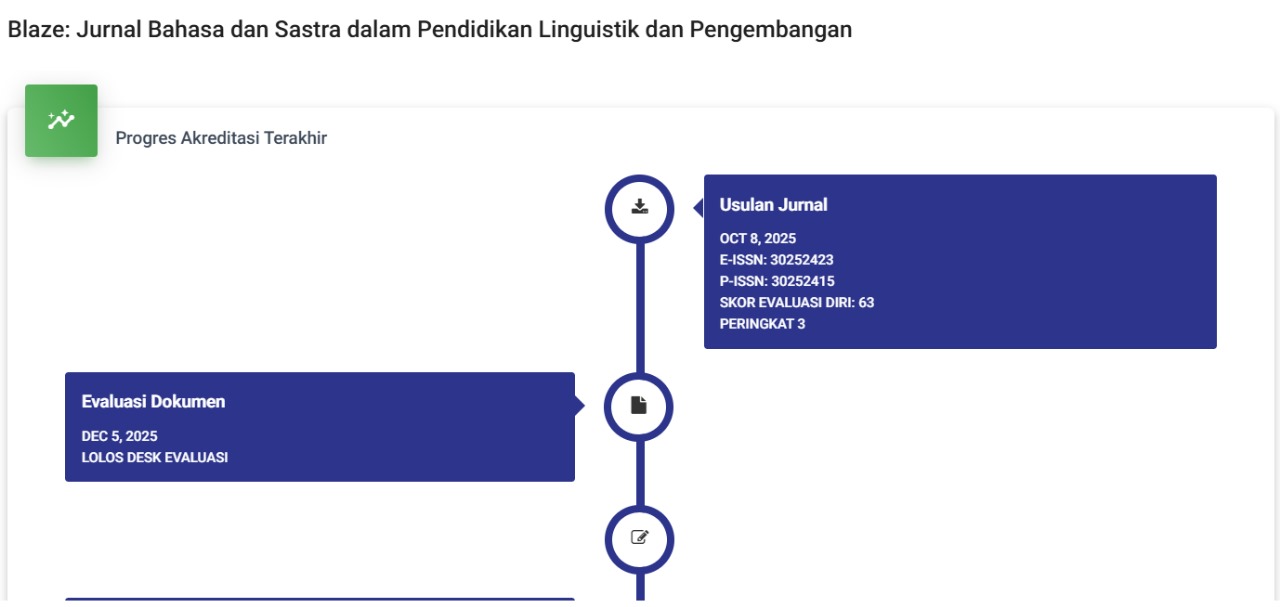Klasifikasi Lingual Jajanan Tradisional Desa Cemagi
DOI:
https://doi.org/10.59841/blaze.v2i2.1166Keywords:
lingual, Cemagi Village, Anthropology Linguistic, Traditional Snacks, HindusAbstract
Lingual or language is an integral part of the cultural expression of a society, is used as a means of communicating values, beliefs and customs, has an important social function and fosters a sense of group identity and solidarity. Traditional Balinese snacks for the Cemagi Village society are not just food but also have an important role as a means of traditional ceremonies. A linguistic anthropology approach was used by researchers to reveal the culture of the Cemagi people, in the process of inheriting and passing on the role of traditional snacks in their beliefs as Hindus. It is hoped that the role of traditional snacks can be learned, inherited, passed on from one generation to the next, through actions in the form of face-to-face interactions, and of course through linguistic communication, both verbal and non-verbal. -verbal form. The proposed research is to find out how traditional food exists and to know the lexicon of traditional snacks and their meaning in a traditional ceremony. There were 12 lexicons found in this first research and explained in terms of processing processes and fields of meaning in the beliefs of the Cemagi society. Traditional snacks are used as the main filling material and function as a means in traditional ceremonial processions. Traditional snacks are symbolic and expressive, both in terms of shape, ingredients and taste.
References
Agustin, N. A., Kanom, & Darmawan, R. N. (2020). ANALISIS POTENSI WISATA KULINER IKAN BAKAR SEBAGAI DAYA TARIK WISATA DI PANTAI BLIMBINGSARI BANYUWANGI. Jurnal Inovasi Penelitian, 1(6), 1211–1221.
Ariani, R. P. (2021). Mengenal Kuliner Bali (Issue February). PT. RajaGrafindo Persada. https://desacemagi.badungkab.go.id/jumlah-penduduk
Creswell, J. W., & David, J. (2018). Research Design: Qualitative, Quantitative, and Mixed Methods Approaches (D. C. Felts (ed.); fifth edit). Sage Publication.
Dasa, M. V., Astsawa, I. B. M., & Sudhita, I. N. S. (2013). PEMBERDAYAAN MASYARAKAT DESA PAKRAMAN DALAM PENGEMBANGAN DESA CEMAGI SEBAGAI DAERAH WISATA ALAM (TINJAUAN GEOGRAFI PARIWISATA). Jurnal Pendidikan Geografi Undhiksa, 1(July), 1–23. https://ejournal.undiksha.ac.id/index.php/JJPG/article/view/20357
Duranti, A. (1997). Linguistic Anthropology. Cambridge University Press.
Fuad, A. D., & Hapsari, Y. T. (2018). Ekspresi Jati Diri Bangsa dalam Kekayaan Kuliner Nusantara:Telaah Antropolinguistik. In Indonesia Sebagai Ruang Imajinasi (Vol. 2).
Hadiyayah, Y. N. (2016). Leksikon Makanan Tradisional Sunda di Kabupaten Kuningan(Kajian Etnolinguistik). Lokabasa, 7(1), 94. https://doi.org/10.17509/jlb.v7i1.3425
Kardana, I. N., Mahayana, I. M. A., Ngurah, I. G., & Rajistha, A. (2020). The Dynamics of Balinese Lexicon in Sanur Tourism Area : An Ecolinguistic Approach. The International Linguistics Research, 3(4), 142–151. https://j.ideasspread.org/index.php/ilr/article/view/767/660
Koentjaraningrat. (1981). Pengantar Ilmu Antropologi (Radar Jaya Offset (ed.); 3rd ed.). Radar Jaya Offset - Jakarta.
Pujawan, A. A. K. A., & Trisdayanti, N. P. E. (2017). EKSPLORASI MAKANAN TRADISIONAL BALI DI KABUPATEN BANGLI. JURNAL GASTRONOMI INDONESIA, 5(1), 1–23. http://ojs.ppb.ac.id/index.php/jgi/article/view/93
Putra, A. M., Aryanti, N. N. S., Astina, I. K., & Setiawan, I. D. (2019). PENGEMASAN KULINER LOKAL DAN CINDERAMATA LOKAL DALAM MENDUKUNG PENGEMBANGAN DESA WISATA TISTA, KECAMATAN KERAMBITAN, KABUPATEN TABANAN. JURNAL Perhotelan Dan Pariwisata, 9(1), 1–18. http://triatmajaya.ejurnal.info/index.php/triatmajaya/article/view/109
Rosidin, O., Riansi, E. S., & Muhyidin, A. (2021). Leksikon Kuliner Tradisional Masyarakat Kabupaten Pandeglang. Litera, 20(1), 49–75. https://journal.uny.ac.id/index.php/litera/article/view/33908
Sharifian, F. (2017). Cultural Linguistics and linguistic relativity. In Language Sciences (Vol. 59, pp. 83–92). https://doi.org/10.1016/j.langsci.2016.06.002
Sibarani, R. (2015). Pendekatan Antropolinguistik Terhadap Kajian Tradisi Lisan. RETORIKA: Jurnal Ilmu Bahasa, 1(1), 1. https://doi.org/10.22225/jr.v1i1.9
Situmorang, O., & Sibarani, R. (2020). TRADISI BUDAYA DAN KEARIFAN LOKAL PAULAK UNE DAN MANINGKIR TANGGA PADA PERNIKAHAN BATAK TOBA DI DESA SIGAPITON KECAMATAN AJIBATA: KAJIAN ANTROPOLINGUISTIK. Jurnal Kompetensi, 14(2), 82–91.
Sudibya, B. (2018). Wisata Desa dan Desa Wisata. JURNAL BAPPEDA LITBANG, 1(1), 21–25. https://media.neliti.com/media/publications/333746-wisata-desa-dan-desa-wisata-49e7fcf1.pdf
Supatmiwati, D., Suktiningsih, W., Sutarman, Abdussamad, Z., & Muhid, A. (2021). AN ECOLINGUISTIC STUDY ON ECOSPIRITUAL TOURISM OF REBO BUNTUNG COMMODDIFICATION. Lingua Cultura, 10(November), 183–189. https://doi.org/10.21512/humaniora.v10i3.5874
Widani, N. N., Lumanauw, N., & Suktiningsih, W. (2021). Indeksikalitas Makanan Tradisional dalam Upacara Pawiwahan Masyarakat Desa Tibuneneng. Humanitatis: Journal of Language and Literature, 8(1), 35–52. https://journal.universitasbumigora.ac.id/index.php/humanitatis/article/view/1465
Widayati, D. (2018). Leksikon Kuliner sebagai Cermin Budaya Kuliner Masyarakat Melayu Pesisir Timur Sumatera Utara. Kongres Internasional Masyarakat Linguistik Indonesia (KIMLI), 43--49.
Zhanalina, L. K., & Ordahanova, A. B. (2015). Substance and Methods of Cognitive Approach in Linguistics. Procedia - Social and Behavioral Sciences, 192, 720–723. https://doi.org/10.1016/j.sbspro.2015.06.071
Downloads
Published
How to Cite
Issue
Section
License
Copyright (c) 2024 BLAZE : Jurnal Bahasa dan Sastra dalam Pendidikan Linguistik dan Pengembangan

This work is licensed under a Creative Commons Attribution-ShareAlike 4.0 International License.








